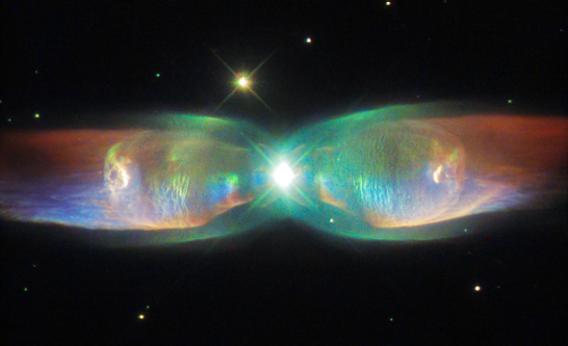Create a free profile to get unlimited access to exclusive videos, sweepstakes, and more!
Painting the Wings of the Butterfly Nebula

As I’ve mentioned a bazillion times before, I’m fascinated by planetary nebulae. These are winds of gas blown off by dying stars, illuminated and set to glow by the hot stars in their centers, and generally sculpted into fantastic shapes that can be anything from thin soap bubbles to highly elongated cylindrical barrels.
One of the most spectacular is M2-9, a double-lobed beastie very roughly 2,000 light-years away. The image above was recently released, using older images from Hubble combined with a new one taken using STIS, a Hubble camera I actually worked on for many years. The colors in this image are a little different than usual; the blue is from tenuous oxygen in the nebula that’s usually colored green (it appears about the same color as a green laser pointer to our eyes), and red—usually indicative of hydrogen—is instead from sulfur.
Some people call this the Butterfly Nebula, but I’ve never thought it looks very lepidopterate. It looks more like two squids kissing.
The extreme elongation of this nebula is rare, and a bit puzzling. Usually, this sort of symmetry comes from the central star being a binary, two stars orbiting each other. Gas blown off by the dying star of the pair gets thrown out along the equator of the system, forming a thickish disk. When the star loses enough of its outer layers, the hot core is exposed. A faster wind picks up, but finds its path blocked by the disk. It blows up and out instead, forming the bipolar shape.
But there are some subtle issues with this scenario when you look closely at the nebula. For example, there are nested shells; you can see an inner reddish one and an outer green one. The red one appears to be brighter on the bottom, and in both lobes. That’s weird. You sometimes get bright spots in both lobes, but they’re on opposite sides. That’s usually caused by jets of material blasting out from the star, and if it’s tipped a bit, it hits the lobes on opposite sides (hold a pencil between your thumb and forefinger, then tip it a little; one end points to the left and the other to the right. Same thing; and we call that a precessing jet, where the spin axis wobbles around).
I found a paper by my friends and colleagues Mario Livio and Noam Soker, and they came up with a clever explanation. They propose that the two stars are a dying red giant and a hot white dwarf. The red giant is blowing a slow, dense wind. The white dwarf is drawing that material in, which forms a disk around it. This collimates (focuses) the wind from the white dwarf, which is much faster. But this fast wind gets bent to the side when it hits the slower wind.
In the diagram above it bends to the left. But this only shows the upper half of the picture; there’s also a lower half that’s a mirror reflection. In that, the white dwarf wind blowing down is also bent to the left, and that’s why we see brightening on the same sides of the lobes.
The two stars orbit each other every 120 years or so. As they do, the white dwarf wind moves around, slamming into the sides of the lobes, making a different part of the nebula glow. It’s like standing in the middle of a room with a flashlight and spinning around; you illuminate different parts of the walls with time.
This animation was put together from actual observations of the nebula; note how the glow moves around over time, illuminating the same sides of both lobes:
That’s exactly what Mario and Noam would predict it to do. Their hypothesis isn’t proven by this, but it’s very compelling to me. It makes a lot more sense than a precessing jet.
I mentioned Noam not long ago, in my Crash Course Astronomy episode about planetary nebulae. I also mention that for many nebulae, the binary stars would have to be very close together to make these shapes, “improbably close.” I may need to reassess that idea. Under some circumstances they don’t have to be all that close to generate these strange and fantastic shapes.
But then, that’s what science is all about, right? Reassessing your ideas, making sure you’re not holding on to ones that aren’t correct. I spent a while studying these objects, and I’ll be honest: It’s pretty cool to find out that sometimes even a few of my basic ideas about them need to be tweaked.


























